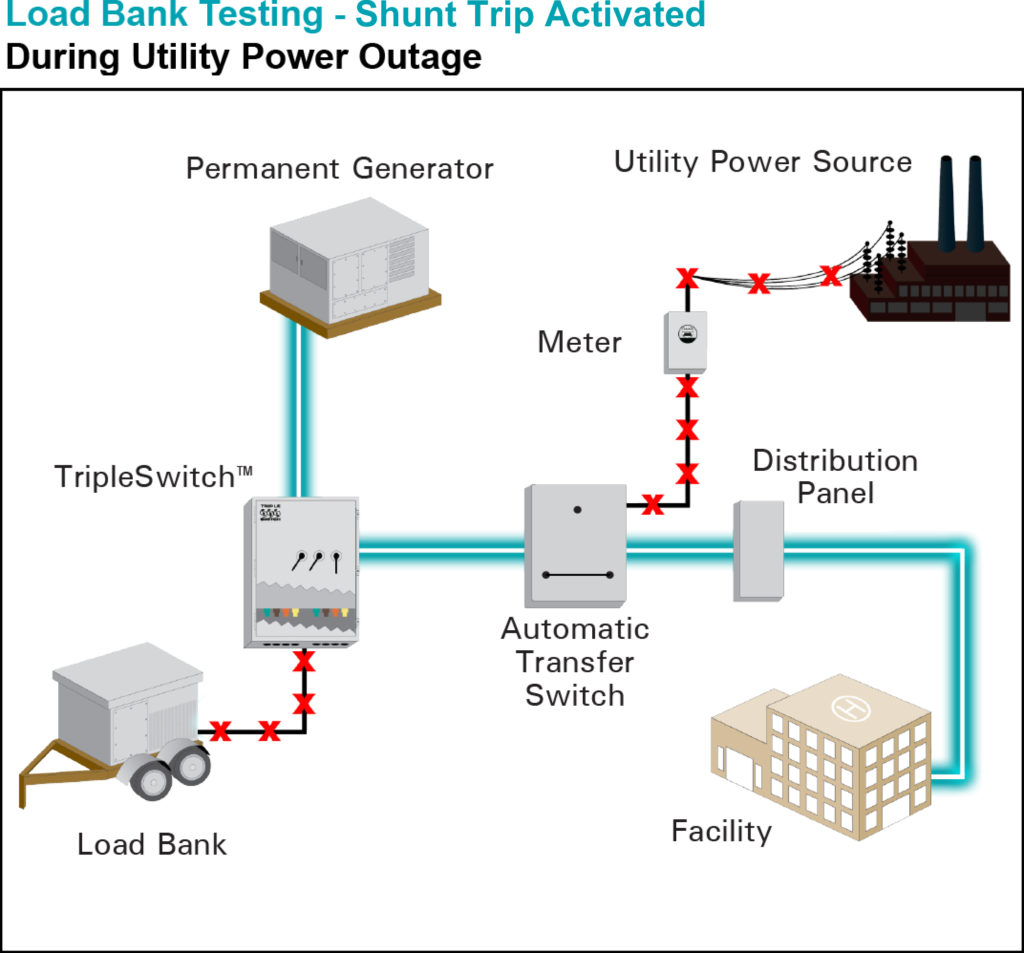Disclosure: This post contains affiliate links and I will be compensated if you make a purchase after clicking through my links. Learn More
A load bank for a generator is a device used to test and validate the performance of a generator. It simulates electrical loads, ensuring the generator operates correctly under various conditions.
Generators are crucial for reliable power supply during outages or in remote locations. But how do you ensure your generator performs well when needed? Enter the load bank. This essential tool mimics real-life electrical loads, allowing you to test your generator’s capabilities safely and effectively.
Using a load bank helps identify potential issues before they become problems, ensuring your generator is ready for action. In this blog post, we’ll explore what a load bank is, how it works, and why it’s vital for maintaining your generator’s health. Let’s dive in and understand the importance of load banks in generator maintenance.

Credit: www.wpowerproducts.com
Introduction To Load Banks
Generators are essential for providing backup power during outages. To ensure they work efficiently, load banks play a crucial role. In this section, we will explore the basics of load banks and their importance for generators.
Definition
A load bank is a device that tests the capacity and performance of a generator. It simulates electrical loads to ensure the generator runs smoothly. Load banks help in maintaining and verifying the generator’s reliability.
Importance
Load banks are vital for the proper functioning of generators. They help identify potential issues before a real power outage occurs. Regular testing with load banks ensures that generators are ready for emergencies. This prevents unexpected failures and costly downtime.
Load banks also contribute to the longevity of generators. By testing under various conditions, they reduce the risk of damage. This ensures generators operate efficiently for a longer period.
Types Of Load Banks
A load bank for a generator tests its performance by applying an electrical load. Different types include resistive, reactive, and capacitive load banks. These simulate various conditions, ensuring the generator operates efficiently and safely.
When you own a generator, it’s crucial to ensure it operates efficiently and reliably. One way to do this is through load bank testing. Load banks come in various types, each serving specific testing needs. Understanding these types can help you choose the right one for your generator.
Resistive Load Banks
Resistive load banks are the most common type. They simulate real-world electrical loads by converting electrical energy into heat. This makes them ideal for testing generators and UPS systems.
Imagine having a heater in your home. It consumes electricity and produces heat. Resistive load banks work similarly, but on a larger scale.
You can use resistive load banks to test the full capacity of your generator. They help ensure that your generator can handle its maximum rated load. This is crucial for preventing unexpected failures during actual use.
Reactive Load Banks
Reactive load banks add a layer of complexity. They simulate inductive and capacitive loads. This means they can mimic the type of loads seen in industrial environments.
Reactive load banks are perfect for testing generators used in factories. These environments often have equipment like motors and transformers that create reactive loads.
Using a reactive load bank helps you understand how your generator handles different power factors. This is vital for ensuring stability and efficiency in industrial settings.
Combined Load Banks
Combined load banks offer the best of both worlds. They can simulate resistive and reactive loads simultaneously. This makes them incredibly versatile.
Imagine you need to test a generator used in a hospital. Hospitals have a mix of equipment, from lights to MRI machines. A combined load bank can mimic these varied loads effectively.
Using combined load banks ensures your generator is ready for any situation. They provide a comprehensive test, giving you peace of mind.
Choosing the right load bank for your generator is essential. It ensures your generator performs reliably when you need it most. So, which type of load bank do you think fits your needs best?
Applications Of Load Banks
Load banks are essential for testing and maintaining generators. They ensure generators operate efficiently under load conditions. Different sectors rely on load banks for varied purposes. Here, we explore the key applications across commercial, industrial, and military domains.
Commercial Use
Commercial buildings often require backup power. Load banks help test these backup generators. They simulate actual working conditions. This ensures generators kick in during power outages. Regular load bank testing can prevent unexpected failures. It ensures smooth operation when needed most.
Industrial Use
Industries like manufacturing and data centers need reliable power. Load banks test generators in these settings. They ensure generators handle real-world loads. Testing helps identify potential issues early. This minimizes downtime and prevents costly disruptions. Load banks are vital for maintaining operational efficiency.
Military Use
Military operations rely on power in remote locations. Load banks test generators used in these critical situations. They ensure generators perform under harsh conditions. Regular testing maintains readiness and reliability. This is crucial for mission success. Load banks help maintain power supply integrity in the field.
Components Of Load Banks
Load banks are essential for testing generators. They simulate real electrical loads. Understanding their components helps in grasping their function.
Power Elements
Power elements are the heart of load banks. They create electrical loads. These elements can be resistive, inductive, or capacitive. Resistive elements use heaters or resistors. Inductive elements use coils or transformers. Capacitive elements use capacitors. Each type serves a different testing purpose.
Control Systems
Control systems manage the load bank operations. They adjust the load applied to the generator. Manual control systems have switches and dials. Automated systems use software for precise control. These systems ensure accurate testing conditions.
Safety Features
Safety features protect the equipment and operators. Over-temperature sensors prevent overheating. Emergency stop buttons offer a quick shutdown. Cooling systems maintain safe temperatures. Circuit breakers prevent electrical overloads. These features ensure safe and reliable testing.
Benefits Of Load Bank Testing
Load bank testing offers several benefits for maintaining and verifying generator performance. It helps ensure your generator operates at peak efficiency. Regular testing identifies potential issues before they become significant problems. This testing is crucial for preventing costly downtime and ensuring regulatory compliance.
Performance Verification
Load bank testing verifies your generator’s performance under various loads. It checks if the generator can handle its rated capacity. This process ensures the generator can supply power during an actual outage. It also helps identify any weaknesses in the system. Regular testing ensures your generator is always ready.
Preventive Maintenance
Regular load bank testing plays a key role in preventive maintenance. It helps detect minor issues before they become major problems. Testing under load stresses the generator and simulates real-world conditions. This process reveals potential failures and ensures all components are working correctly. Identifying issues early saves time and repair costs.
Regulatory Compliance
Many industries require generators to meet specific regulatory standards. Load bank testing ensures compliance with these regulations. Regular testing provides documentation of your generator’s performance. This documentation is essential for passing inspections and audits. Ensuring compliance avoids fines and legal issues.

Credit: www.gotpower.com
Steps In Load Bank Testing
A load bank for a generator simulates electrical loads to test the generator’s performance. Steps in load bank testing include connecting the load bank, starting the generator, and gradually applying loads. This ensures the generator runs smoothly under different conditions.
When dealing with generators, load bank testing is essential. It ensures your generator is ready to handle real-world demands. This section will guide you through the steps in load bank testing, helping you understand what to expect.
Preparation
Start by ensuring your generator is in good condition. Check oil and coolant levels. Inspect for leaks or visible damage.
Safety is crucial. Make sure all personnel involved are aware of the procedures. Use personal protective equipment.
Gather necessary tools and equipment. This includes cables, connectors, and the load bank itself. Ensure everything is within easy reach.
Execution
Connect the load bank to the generator. Follow the manufacturer’s instructions precisely. This step is critical to avoid any mishaps.
Gradually apply the load. Start with a small percentage, then increase incrementally. Monitor the generator’s response at each stage.
Record data at each load level. Note the voltage, frequency, and other essential metrics. This information is vital for evaluating performance later.
Evaluation
Review the recorded data carefully. Look for any deviations from the expected performance. This helps identify potential issues.
Assess the generator’s stability. Did it maintain voltage and frequency under load? Consistency is a good sign.
Consider the generator’s recovery time. How quickly did it return to normal after removing the load? A quick recovery indicates a healthy system.
Regular load bank testing ensures your generator is reliable. It’s a small investment of time for peace of mind. Have you scheduled your next test?
Choosing The Right Load Bank
Choosing the right load bank for your generator is crucial. It ensures your generator performs well. A load bank tests your generator. It mimics the operational load. This helps in maintaining and verifying the generator’s health.
Several factors come into play. One must consider capacity requirements, compatibility, and portability. Let’s dive deeper into each of these factors.
Capacity Requirements
Understand your generator’s capacity. The load bank must match or exceed this capacity. This ensures effective testing. Overloading can damage the generator. Underloading won’t provide accurate results. Always check your generator’s specifications.
Compatibility
Ensure the load bank is compatible with your generator. Check voltage and phase requirements. Different generators have different specifications. Compatibility ensures safe and effective testing. It also prevents potential damages.
Portability
Consider the load bank’s portability. Portable load banks are easy to move. They are suitable for different locations. This adds convenience. Fixed load banks are better for stationary generators. Think about your needs before deciding.

Credit: eslpwr.com
Common Challenges
Load banks test generators by simulating real electrical loads. They ensure the generator works correctly under various conditions. Regular testing helps prevent unexpected failures.
When using a load bank for a generator, you might encounter several common challenges. These issues can affect the performance and reliability of your generator, leading to costly downtime and repairs. Understanding these challenges can help you take preventive measures to ensure your generator runs smoothly.
Overheating Issues
Overheating is a major concern when using a load bank. This can happen if the generator is not properly ventilated or if the load bank is pushing the generator beyond its capacity.
You might notice the generator shutting down unexpectedly or emitting strange smells. Regular maintenance and monitoring can help prevent overheating.
Consider installing temperature sensors to get real-time data on your generator’s performance.
Connection Problems
Another common issue is connection problems. Poor connections can lead to inaccurate load testing and even damage your equipment.
Make sure all cables and connectors are in good condition and securely attached. Loose connections can cause intermittent power issues and unreliable test results.
Double-check your setup before starting the load test to avoid these problems.
Data Accuracy
Ensuring data accuracy is crucial for effective load bank testing. Inaccurate data can lead to incorrect conclusions about your generator’s performance.
Use reliable and calibrated equipment to collect data. Periodically verify the accuracy of your measurement tools to maintain confidence in your test results.
Consider using software solutions that can help you track and analyze the data more efficiently.
Have you experienced any of these challenges when using a load bank? What steps did you take to overcome them? Share your thoughts and experiences in the comments below!
Future Trends
The future of load banks for generators is evolving rapidly. Innovations in technology are driving advancements. Sustainability is becoming a key focus. Automation is transforming how load banks operate.
Advanced Technologies
Advanced technologies are shaping load banks. Digital monitoring systems are more common. These systems provide real-time data. This helps in better performance analysis. Predictive maintenance is another trend. It uses data to foresee issues before they occur. This reduces downtime.
Sustainability
Sustainability is crucial for future load banks. Eco-friendly designs are emerging. These designs reduce environmental impact. Renewable energy sources are being integrated. Solar and wind power are examples. Energy-efficient components are used. This lowers energy consumption.
Automation
Automation is revolutionizing load banks. Automated testing procedures are now available. These procedures increase efficiency. They also improve accuracy. Remote operation is a growing trend. It allows control from any location. This enhances convenience.
Frequently Asked Questions
Do I Need A Load Bank For A Generator?
Yes, a load bank is essential for a generator. It ensures optimal performance by simulating electrical loads. This prevents wet stacking, verifies system reliability, and helps in regular maintenance. A load bank keeps your generator in top condition, ready for emergencies.
How Often Should You Load Bank A Generator?
Load bank a generator every 6 months to ensure optimal performance and reliability. Regular testing prevents issues and extends lifespan.
What Does A Generator Bank Do?
A generator bank provides backup power, ensuring continuous electricity supply during outages. It combines multiple generators for reliability.
How To Perform A Load Bank Test On A Generator?
To perform a load bank test on a generator, connect the load bank, start the generator, and gradually apply loads. Monitor voltage, frequency, and temperature. Record the performance data.
Final Words
A load bank is crucial for generator testing and maintenance. It helps ensure reliability and efficiency. Regular testing with a load bank prevents future failures. This practice extends the life of your generator. Investing in a load bank saves time and money.
It also provides peace of mind. With a load bank, your generator remains ready for any situation. Understanding this tool is essential for generator owners. Always prioritize proper generator care and testing.








